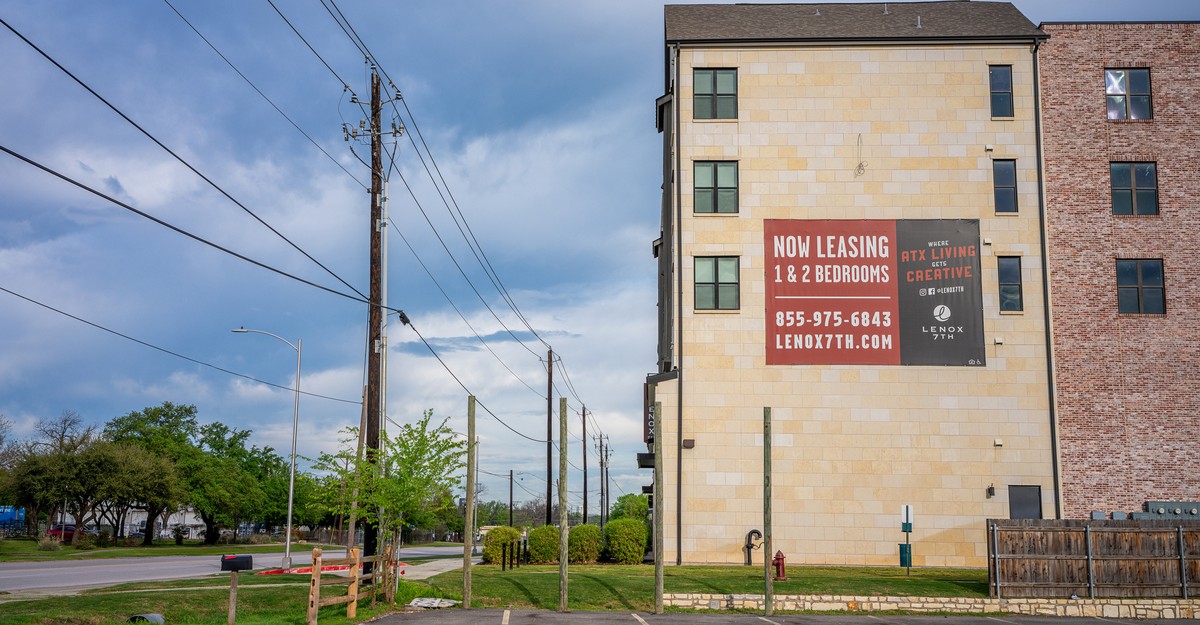If you want to understand America’s strange relationship with housing in the 21st century, look at Austin, where no matter what happens to prices, someone’s always claiming that the sky is falling.
In the 2010s, the capital of Texas grew faster than any other major U.S. metro, pulling in movers from around the country. Initially, downtown and suburban areas struggled to build enough apartments and single-family homes to meet the influx of demand, and housing costs bloomed across the region. Since the beginning of the pandemic, even as rent inflation has gone berserk nationwide, no city has experienced anything like Austin’s growth in housing costs. In 2021, rents rose at the most furious annual rate in the city’s history. In 2022, rent growth exceeded every other large city in the country, as Austin’s median rent nearly doubled.
This might sound like the beginning of a familiar and depressing story—one that Americans have gotten used to over the past few decades, especially if they live in a coastal blue state. California and New York, anchored by “superstar” clusters in Silicon Valley, Hollywood, and Wall Street, have pulled in some of the nation’s most creative workers, who have pushed price levels up. But a combination of stifling construction regulations, eternal permitting processes, legal tools to block new development, and NIMBY neighbors restricted the addition of more housing units. Rent and ownership costs rose in America’s richest cities, until families started giving up and moving out. As the economics writer Noah Smith has argued, California and New York are practically driving people out of the state “by refusing to build enough housing."
But Austin—and Texas more generally—has defied the narrative that skyrocketing housing costs are a problem from hell that people just have to accept. In response to rent increases, the Texas capital experimented with the uncommon strategy of actually building enough homes for people to live in. This year, Austin is expected to add more apartment units as a share of its existing inventory than any other city in the country. Again as a share of existing inventory, Austin is adding homes more than twice as fast as the national average and nearly nine times faster than San Francisco, Los Angeles, and San Diego. (You read that right: nine times faster.)
The results are spectacular for renters and buyers. The surge in housing supply, alongside declining inbound domestic migration, has led to falling rents and home prices across the city. Austin rents have come down 7 percent in the past year.
One could celebrate this report as a win for movers. Or, if you’re The Wall Street Journal, you could treat the news as a seriously frightening development.
“Once America’s Hottest Housing Market, Austin Is Running in Reverse,” announced the headline of the top story on the WSJ website on Monday. The article illustrated “Austin’s recent downswing” and its “glut of luxury apartment buildings” with photographs of abandoned downtown plazas, as if the fastest-growing city of the 2010s had been suddenly hollowed out by a plague and left to zombies and tumbleweeds.
Running in reverse. Downswing. Glut. This is the same Wall Street Journal that, in 2021, noted that rent inflation was demolishing American budgets and, in 2022, gawked at all-time-high rents in places like New York City. Sure, falling housing costs are an annoyance if you’re trying to sell your place in the next quarter, or if you’re a developer operating on the razor’s edge of profitability. But this outlook seems to set up a no-win situation. If rising rent prices are bad, but falling rent prices are also bad, what exactly are we supposed to root for in the U.S. housing market?
This is a surprisingly complex question for Americans today. In the U.S., our houses are meant to perform contrary roles in society: shelter for today and investment vehicle for tomorrow. This approach creates a kind of temporal disjunction around the housing market, where what appears sensible for one generation (Please, no more construction near me, it’s annoying and could hurt my property values!) is calamitous for the next (Wait, there’s nowhere near me for my children to live!).
If homeownership is best understood as an investment, like equities, we should root for prices to go up. If housing is an essential good, like food and clothing, we should cheer when prices stay flat—or even when they fall. Instead, many Americans seem to think of a home as existing in a quantum superposition between a present-day necessity and a future asset.
This magical thinking isn’t just a phenomenon of real-estate reporting. It is deeply rooted even in the highest echelons of policy making. Just look at the Democratic Party’s 2020 platform. The document reads (emphasis mine):
Homeownership has long been central to building generational wealth, and expanding access to homeownership to those who have been unfairly excluded and discriminated against is critical to closing the racial wealth gap.
But then the same platform goes on to say (emphasis mine):
Housing in America should be stable, accessible, safe, healthy, energy efficient, and, above all, affordable. No one should have to spend more than 30 percent of their income on housing, so families have ample resources left to meet their other needs and save for retirement.
See the issue? On the one hand, the Democratic Party says we are all relying on homeownership to close the racial wealth gap, which implies that we should root for today’s home values to significantly rise, so that today’s minority owners can build wealth. On the other hand, the party says we need houses to be “above all, affordable.” In that case, we should despair when home values rise too fast, because it implies that the next generation of owners will be priced out of the market.
I don’t think the authors of the Democratic Party platform are careless or clueless. I think they’re doing their best to articulate a folk wisdom: Housing should, somehow, deliver permanent affordability and constant appreciation, at the same time. And perhaps they’re trying to reconcile the awkwardness of a market where ordinary middle-class people are both sellers and buyers of an essential yet expensive good; where high inflation would help some people, while deflation would help others.
Americans’ inconsistent approach to housing doesn’t end with these contradictory desires. In 2022, three economists asked several thousand Americans a few simple questions about how supply and demand works in various markets. For example, if automakers suddenly stopped making new cars and trucks, what happens to the price of used vehicles? Or, if a farm started using an amazing new fertilizer and got a huge boost in grain yield, what will happen to the price of the grain? Contrary to the assumption that Americans don’t understand basic economics, the survey respondents did pretty well on the test. They correctly guessed that a shortage of cars would shift car prices up and that a surge in grain production would shift grain prices down. So far, so good.
Then the economists asked the participants about housing. They said: If a new law makes it easier to build dwellings near train stops, what happens to housing prices? Well, all of a sudden, the laws of supply and demand no longer applied. More than a third of participants said that “a large, exogenous increase in their region’s housing stock” would cause rents and home prices to rise. “The public understands the implications of supply and demand in markets for agricultural commodities, for labor, and even for cars, a durable consumer good that, like housing, trades in new and second-hand markets,” the authors wrote. Only when the subject is housing do many Americans despair that you can never build your way out of a shortage.
Housing is a pit of oxymoronic thinking. The Wall Street Journal tells its readers that it’s bad when rents go up but also bad when rents go down. The Democratic Party platform says homes have to be affordable and also that they ought to appreciate faster than the rate of inflation. Americans in research surveys say that if grain yields surge, grain prices go down, but that if housing construction surges, housing costs go up.
I’m listing these examples not to be despondent about the prospects for housing abundance, but rather to be realistic. Housing is, in fact, both a present need and a future investment. In a dual-side marketplace, I suppose you could argue that any change in price is bad for some party. But the externalities of housing abundance outweigh the loss to any particular party rooting to profit from scarcity. More and denser housing has been found to reduce inequality and raise personal income; to increase individual exercise rates and reduce obesity; to limit carbon emissions and preserve thousands of acres of natural splendor; and even to increase productivity and innovation.
The miracle of Austin is helpful to recognize, because it restores clarity to a simple truth: Houses are essential, but they are not magical. The normal rules of supply and demand apply. Perhaps more blue cities and states should make a point of applying those rules—and build more damn homes.
That is one ugly building. And those lines should be buried.



